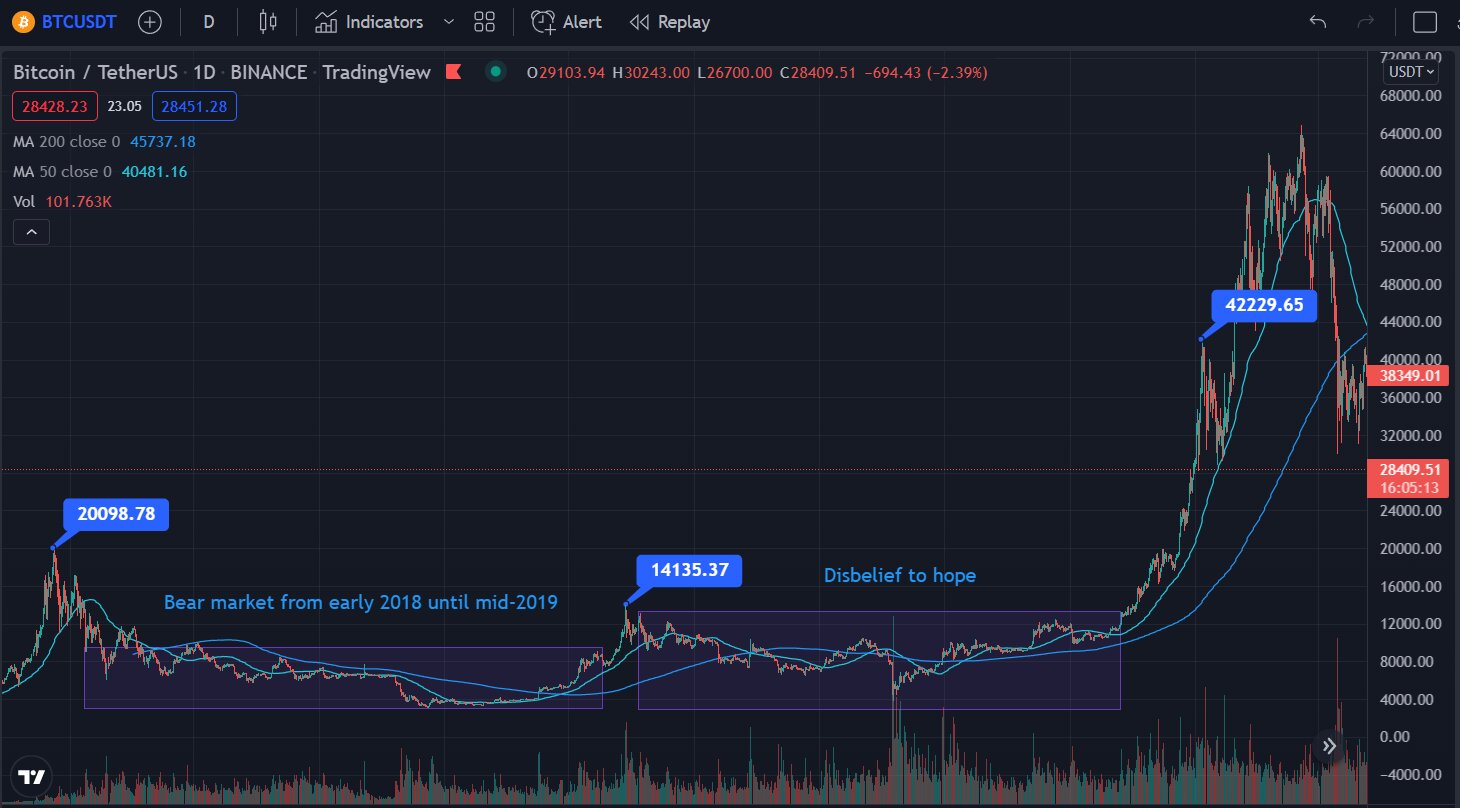Introduction
Welcome to the world of cryptocurrencies, where the weather can be as unpredictable as the markets themselves. In the volatile landscape of crypto, periods of intense price decline and market pessimism are often referred to as “crypto winters.” Just as the depths of winter can be harsh and long, so too can crypto winters test the endurance and patience of investors and enthusiasts.
A crypto winter is a term used to describe a prolonged bear market in the cryptocurrency industry, characterized by a significant decline in overall market values and investor sentiment. During these periods, prices of cryptocurrencies often experience sharp drops, trading volumes decrease, and the optimism that once surrounded the market fades away.
Similar to how winter can be influenced by various factors like temperature and weather patterns, the duration and severity of a crypto winter are influenced by several factors within the cryptocurrency market. These factors can range from market trends and investor sentiment to regulatory changes and technological advancements.
In this article, we will explore the factors that influence the duration of a crypto winter and delve into historical examples to understand how long these periods can last. We will also discuss the lessons learned from previous crypto winters and identify signs that may indicate the end of a crypto winter. So, grab your hot beverage and let’s dive into the chilly world of crypto winters.
Definition of a Crypto Winter
A crypto winter can be best described as a period of time in the cryptocurrency market when there is a significant downturn, marked by a decline in prices, trading volume, and overall investor sentiment. It is a phase where the market experiences a prolonged bearish trend, causing many investors and enthusiasts to lose hope and confidence in the market.
During a crypto winter, the prices of cryptocurrencies tend to plummet, often reaching new lows. The market becomes flooded with pessimism and uncertainty, leading to a decrease in trading activity. Investors may become wary of entering the market or decide to sell off their holdings, exacerbating the downward pressure on prices.
Furthermore, the sentiment among investors and the general public during a crypto winter is usually one of skepticism and caution. The once buzzworthy and promising world of cryptocurrencies loses its luster, and the mainstream media tends to focus on the negative aspects, further fueling the negative sentiment.
It is important to note that a crypto winter is not a temporary dip in prices or a short-term correction but rather a more prolonged period of decline. It can endure for several months or even years, making it a challenging time for those who are heavily invested in the market.
Unlike traditional financial markets, the cryptocurrency market is highly volatile and susceptible to market manipulation, regulatory changes, and technological advancements. These factors play a significant role in the occurrence and duration of a crypto winter.
Now that we have a clear understanding of what a crypto winter entails, let’s explore the factors that influence the duration of these periods and how they can vary from one crypto winter to another.
Factors Influencing the Duration of a Crypto Winter
The duration of a crypto winter can vary widely, depending on several factors that have a significant impact on the cryptocurrency market. Understanding these factors can provide insights into why some crypto winters are shorter or longer than others. Let’s explore some of the key factors influencing the duration of a crypto winter:
1. Market Sentiment: Investor sentiment plays a crucial role in the duration of a crypto winter. During periods of extreme pessimism, when investors lose faith in the market and fear further price declines, it can prolong the bearish phase. On the other hand, if investors regain confidence and start seeing potential opportunities, it can help shorten the duration of the crypto winter.
2. Regulatory Environment: Regulatory changes and government interventions can significantly impact the duration of a crypto winter. Uncertainty surrounding regulations can lead to increased caution among investors and companies, which can prolong the bear market. On the contrary, positive regulatory developments and clear guidelines can boost confidence and potentially shorten the duration of a crypto winter.
3. Technological Advancements: The pace of technological advancements in the cryptocurrency space can also influence the duration of a crypto winter. New and innovative technologies, such as scalability solutions, improved security measures, and user-friendly interfaces, can reinvigorate investor interest and potentially shorten the bearish phase.
4. Market Manipulation: The presence of market manipulation can have a significant impact on the duration of a crypto winter. Manipulative practices, such as pump-and-dump schemes or price manipulation by large players, can prolong the bear market by artificially suppressing prices and eroding investor trust. Detecting and mitigating market manipulation are crucial for restoring confidence and shortening the duration of a crypto winter.
5. External Economic Factors: External economic factors, such as global financial crises or geopolitical events, can also affect the duration of a crypto winter. In times of economic uncertainty or instability, investors tend to flock towards safe-haven assets, diverting their attention and resources away from the cryptocurrency market. These external factors can prolong the bearish phase but can also create opportunities for cryptocurrencies to emerge as an alternative investment option.
By keeping these influencing factors in mind, we can gain a better understanding of why some crypto winters are shorter while others endure for longer periods. In the next section, we will examine historical examples of crypto winters to provide further insights into their duration and patterns.
Historical Crypto Winters
To gain a deeper understanding of the duration and patterns of crypto winters, let’s explore some historical examples of significant bear markets in the cryptocurrency industry:
1. The Great Crypto Winter of 2018-2019: This crypto winter was one of the most notable and longest-lasting bear markets in the history of cryptocurrencies. It started in late 2017 when the market experienced a massive price bubble, followed by a substantial correction in early 2018. The bear market persisted for over a year, with prices steadily declining and investor sentiment remaining pessimistic. It wasn’t until early 2019 that signs of recovery started to emerge, leading to the end of this extended crypto winter.
2. The Bitter Cold of 2013-2015: In this period, following the initial excitement and rapid growth of Bitcoin, the market faced a significant downturn. Starting in late 2013, the price of Bitcoin experienced a sharp decline, and the bear market continued until early 2015. This crypto winter lasted for approximately two years, with prices reaching new lows. However, by the end of 2015, the market began to regain its strength, and gradual recovery followed.
3. The Chilling Frost of 2011-2012: During this period, the cryptocurrency market faced its first major winter. In 2011, the price of Bitcoin experienced a significant decline after reaching its first all-time high. The bear market continued into 2012, with prices finding a bottom around mid-year. This crypto winter lasted for about a year and a half before the market started showing signs of recovery.
These historical examples showcase that crypto winters can vary in terms of duration. While some may endure for several years, others may last for a relatively shorter period. The factors influencing these durations can be a combination of market sentiment, regulatory developments, technological advancements, and economic conditions.
By studying the patterns and characteristics of these crypto winters, we can gather valuable insights into potential future market trends. In the next section, we will discuss the lessons learned from these past periods of market decline.
The Great Crypto Winter of 2018-2019
The crypto winter of 2018-2019 was one of the most significant and prolonged bear markets in the history of cryptocurrencies. It began in late 2017, following a massive price bubble where cryptocurrencies reached all-time highs. However, the market soon experienced a severe correction, leading to a prolonged period of decline.
During this crypto winter, prices of cryptocurrencies across the board plummeted, and investor sentiment turned pessimistic. The initial excitement and hype surrounding the market faded away as prices continued to decline. Many investors faced significant losses, and some even abandoned the market altogether.
The crypto winter of 2018-2019 lasted for over a year, as the market struggled to find its footing and recover from the extended decline. It wasn’t until early 2019 that signs of a potential turnaround began to emerge. Bitcoin, the leading cryptocurrency, gradually started showing signs of recovery, and other cryptocurrencies followed suit.
Several factors contributed to the duration of this crypto winter. One key factor was the market’s inflated prices during the preceding price bubble. When the bubble burst, it took time for the market to find its true value and stabilize. Additionally, regulatory uncertainties and crackdowns on initial coin offerings (ICOs) also dampened investor sentiment and prolonged the bear market.
Lessons were learned during the great crypto winter of 2018-2019. Many investors realized the importance of conducting thorough research, diversifying their portfolios, and approaching the market with a long-term perspective. It highlighted the need for caution and risk management in the volatile cryptocurrency space.
Moreover, the extended bear market allowed for the development of stronger and more resilient projects and technologies. Companies in the industry had to adapt and refine their strategies to survive in the harsh market conditions. This period also prompted a greater focus on regulatory compliance and investor protection.
The great crypto winter of 2018-2019 serves as a reminder that the cryptocurrency market is highly volatile and subject to significant fluctuations. It is crucial for investors to understand and prepare for market cycles, including prolonged bear markets. By learning from the experiences of this crypto winter, market participants can better navigate future downturns and position themselves for potential recoveries.
The Bitter Cold of 2013-2015
The crypto winter of 2013-2015 was a significant bear market that followed the initial excitement and rapid growth of Bitcoin. It began in late 2013 when the price of Bitcoin reached an all-time high, only to experience a sharp decline shortly after. This downturn marked the start of a challenging period for the entire cryptocurrency market, lasting for approximately two years.
During this bitter cold crypto winter, prices of cryptocurrencies, including Bitcoin, underwent a substantial and prolonged decline. Investor sentiment turned cautious, and many individuals who were euphoric during the previous bull run started to lose faith in the market. The prolonged downturn led to significant losses for those heavily invested in cryptocurrencies.
One of the main contributing factors to the duration of this crypto winter was the bursting of the price bubble. After the initial surge, the market went through a correction phase, causing prices to steadily decline. The market needed time to stabilize and recover from the excesses of the previous period. Regulatory uncertainties and the perception of cryptocurrencies as a speculative asset class further fueled the bearish sentiment.
Despite the challenging market conditions, the crypto winter of 2013-2015 played a crucial role in shaping the cryptocurrency ecosystem. During this period, the industry saw the emergence of new projects and technologies that sought to address the pitfalls and vulnerabilities exposed during the market downturn. It was a time of introspection and innovation, as participants in the market sought to build stronger foundations for future growth.
Lessons were learned from this bitter cold crypto winter. Investors became more wary of hype-driven projects and speculative investments, realizing the importance of conducting due diligence and evaluating the fundamentals of a cryptocurrency. The market also witnessed increased regulatory scrutiny and calls for transparency and investor protection.
By the end of 2015, the market started showing signs of recovery, gradually regaining its strength. This crypto winter taught the industry the importance of resilience and adaptability, emphasizing the need for long-term thinking and patience in the face of market downturns.
The bitter cold of the 2013-2015 crypto winter serves as a reminder that the cryptocurrency market can experience extended bearish periods. It highlights the cyclical nature of the market and the need for investors and participants to remain vigilant, manage risk, and cultivate a long-term perspective to withstand and potentially thrive during challenging times.
The Chilling Frost of 2011-2012
The crypto winter of 2011-2012 marked the first major downturn in the history of cryptocurrencies. It was a period of chilling frost that followed the initial excitement and growth of Bitcoin. In 2011, Bitcoin reached its first significant price peak, only to experience a sharp decline shortly after. This marked the beginning of a challenging time for the cryptocurrency market.
During this crypto winter, prices of cryptocurrencies, particularly Bitcoin, suffered a significant downturn. Investor sentiment turned cautious, and many individuals who had initially embraced the potential of cryptocurrencies began to question their viability. The market experienced a prolonged period of decline, reaching its lowest point in 2012.
Several factors contributed to the duration of this crypto winter. One of the key factors was the relatively nascent stage of the cryptocurrency market at that time. With limited infrastructure, regulatory frameworks, and public awareness, the market was highly susceptible to wild price swings and manipulation attempts. Lack of investor education and understanding of this new form of digital currency also played a role in extending the frosty period.
Despite the challenging market conditions, the crypto winter of 2011-2012 acted as a valuable learning experience for the cryptocurrency industry. It prompted a greater focus on security and robustness in the development of cryptocurrency protocols and infrastructure. Market participants realized the importance of building trust and enhancing the stability of the market to ensure long-term growth.
Lessons learned during this chilling frost crypto winter continue to shape the cryptocurrency industry. It highlighted the necessity of addressing vulnerabilities, improving market infrastructure, and establishing regulatory frameworks to protect investors and foster greater trust and confidence.
By the end of 2012, the market started to show signs of recovery, with Bitcoin slowly regaining its value and the overall market sentiment improving. This period of recovery marked the end of the chilling frost and a new phase of growth for cryptocurrencies.
The crypto winter of 2011-2012 serves as a reminder of the resilience of cryptocurrencies. Despite facing significant challenges and skepticism, the market has demonstrated its ability to bounce back and evolve. It paved the way for further advancements and innovations in the cryptocurrency industry, setting the stage for future growth.
As the market continues to mature, participants in the cryptocurrency space can draw upon the experiences of this early crypto winter to navigate future downturns and ensure the development of a more robust and sustainable market.
Lessons Learned from Previous Crypto Winters
Previous crypto winters have provided valuable lessons to market participants, investors, and the broader cryptocurrency industry. These lessons have shaped the way we approach and understand the market, helping us navigate future challenges and potentially capitalize on opportunities. Let’s explore some of the key lessons learned from previous crypto winters:
1. Prepare for Market Cycles: Crypto winters serve as a reminder that the cryptocurrency market is characterized by cycles of ups and downs. It is important to be prepared for market volatility and understand that periods of decline are a natural part of the market’s evolution. Investing time in thorough research, diversifying portfolios, and maintaining a long-term perspective can help navigate these cycles.
2. Conduct Due Diligence: Previous crypto winters have taught us the importance of conducting due diligence and thoroughly evaluating projects and investments. It is crucial to scrutinize the fundamentals, the team behind a project, and the technological feasibility before allocating resources. This level of diligence helps to identify more resilient projects amidst a challenging market environment.
3. Manage Risk Adequately: Risk management plays a vital role in navigating crypto winters. Diversifying investments across different cryptocurrencies and asset classes can help mitigate potential losses. Setting stop-loss orders and regularly reassessing investment strategies based on market conditions are key components of risk management in the cryptocurrency market.
4. Continuously Adapt and Innovate: Previous crypto winters have shown the importance of continuous adaptation and innovation in the cryptocurrency industry. Companies that successfully weathered these downturns often had strong foundations, resilient technologies, and the ability to pivot and refine their strategies. Embracing technological advancements and staying ahead of market trends can help companies stay competitive during challenging times.
5. Regulatory Compliance and Investor Protection: Crypto winters have highlighted the importance of regulatory compliance and investor protection. Strong regulatory frameworks that provide clarity and transparency can help increase confidence in the market and protect investors from fraudulent schemes. Collaborating with regulators and proactively addressing regulatory concerns is crucial for the long-term viability of the cryptocurrency industry.
6. Embrace Market Education: Previous crypto winters have underlined the need for enhanced market education and awareness. Educating oneself about the technology, market dynamics, and potential risks is essential for making informed investment decisions. By fostering a better understanding of the cryptocurrency industry, participants can navigate the market more effectively and identify promising opportunities.
By learning from the lessons of previous crypto winters, market participants can approach future market downturns with greater resilience and intelligence. These experiences have helped shape the cryptocurrency industry, leading to stronger market infrastructure, improved investor protections, and a more mature ecosystem.
Signs of the Crypto Winter Coming to an End
After enduring a prolonged crypto winter, investors and market participants eagerly look for signs indicating that the bearish phase is coming to an end. While it is difficult to predict market movements with certainty, there are several indicators that can suggest a potential recovery. Let’s explore some of the common signs that may indicate the end of a crypto winter:
1. Volume and Liquidity Increasing: One promising sign that a crypto winter may be ending is an increase in trading volume and liquidity. As market sentiment improves, more participants become active in buying and selling cryptocurrencies, leading to higher trading volumes. Increased liquidity indicates a growing interest in the market and can contribute to the stabilization of prices.
2. Positive Regulatory Developments: Positive regulatory developments can help restore confidence and mark the end of a crypto winter. Clear guidelines, supportive regulations, and initiatives focused on investor protection can signal a more favorable environment for cryptocurrencies. Regulatory clarity reduces uncertainty and encourages institutional and retail investors to enter the market, potentially leading to a price recovery.
3. Bullish Market Sentiment: A shift in market sentiment from bearish to bullish can be a strong indication of a crypto winter coming to an end. Positive news, increased media coverage, and a growing sense of optimism within the community can contribute to a more positive market sentiment. Bullish sentiment often leads to increased demand for cryptocurrencies, which can drive prices higher.
4. Technical Indicators and Chart Patterns: Traders and analysts often rely on technical indicators and chart patterns to identify potential market trends. Bullish reversal patterns, such as higher lows, breaking through resistance levels, or the emergence of bullish divergence, might suggest that the crypto winter is coming to a close. However, it is important to consider these indicators alongside other factors to form a comprehensive view of the market.
5. Growth in Institutional Adoption: The entry of institutional investors into the cryptocurrency market can serve as a catalyst for the end of a crypto winter. Major financial institutions, hedge funds, and other institutional players showing interest or entering the market demonstrates growing confidence in the sector. Institutional adoption can provide stability, liquidity, and credibility to the cryptocurrency ecosystem, potentially leading to a market recovery.
6. Technological Advancements: Advancements in blockchain technology, scalability solutions, and user-friendly applications can also indicate the end of a crypto winter. These technological improvements address some of the challenges faced during bear markets and can rekindle investor interest. New projects and updates that bring innovation and increased efficiency to the industry can contribute to renewed market enthusiasm.
While these signs may suggest the end of a crypto winter, it is important to approach market predictions with caution. Crypto markets are still subject to volatility, and market dynamics can change rapidly. Investors should conduct thorough research and analysis to ensure a comprehensive understanding of the market before making investment decisions.
Volume and Liquidity Increasing
One of the signs that may indicate the end of a crypto winter is an increase in trading volume and liquidity in the market. During a crypto winter, trading activity tends to be subdued as investor sentiment remains pessimistic. However, as market conditions improve, more participants enter the market, leading to higher trading volumes and increased liquidity.
When trading volume and liquidity rise, it suggests a growing interest and participation in the market. Increased activity can contribute to the stabilization of prices and indicate that the market is experiencing a shift from bearish to bullish sentiment.
Higher trading volume is often seen as a positive sign because it reflects a higher level of market activity. It signifies increased buying and selling pressure, which can lead to more efficient price discovery. Additionally, higher liquidity allows for smoother transactions and reduces the impact of large market orders, which can result in less price volatility.
Several factors can contribute to an increase in trading volume and liquidity during the crypto winter’s end:
a. Improved Investor Confidence: As market sentiment improves, investors regain confidence in the market’s potential. Positive news, favorable regulatory developments, or improved economic conditions can instill confidence and attract more participants to the market, leading to increased trading volume.
b. Market Recovery: A market recovery is often accompanied by increased trading volume. As prices begin to rise, investors may see an opportunity to buy at lower levels or take profits from their earlier investments, resulting in heightened trading activity and increased liquidity.
c. New Market Entrants: The entry of new participants, such as institutional investors or retail traders, can also contribute to increased trading volume and liquidity. Institutional investors, in particular, bring larger capital inflows into the market, which can significantly boost trading activity.
d. Greater Market Accessibility: Technological advancements and the development of user-friendly trading platforms have made the crypto market more accessible to a broader range of investors. Increased accessibility leads to a broader pool of participants, resulting in higher trading volumes and liquidity.
It is important to note that an increase in trading volume and liquidity does not guarantee the end of a crypto winter or a sustained market recovery. Other factors, such as market sentiment and technological advancements, need to be taken into account. Traders and investors should always conduct thorough research and analysis before making investment decisions.
By monitoring trading volume and liquidity in the market, participants can gauge the level of interest and activity, providing valuable insights into potential shifts in market sentiment and the overall health of the cryptocurrency market.
Positive Regulatory Developments
Positive regulatory developments can serve as a significant signal that a crypto winter may be coming to an end. Regulatory clarity and supportive measures from governments and regulatory bodies can restore confidence in the cryptocurrency market and encourage its growth. When investors and businesses have a clear understanding of the rules and regulations governing the market, it can lead to increased trust, participation, and market stability.
Here are some key points to consider regarding positive regulatory developments:
a. Clear Guidelines and Frameworks: The establishment of clear guidelines and regulatory frameworks for cryptocurrencies can provide a much-needed sense of stability and legal certainty. When regulators outline specific rules and requirements for cryptocurrency-related activities, investors and market participants can operate within a structured framework, reducing legal and compliance risks.
b. Enhanced Investor Protection: Positive regulatory developments often focus on enhancing investor protection measures. This can include measures to combat fraud, improve transparency, and implement safeguards against market manipulation. When investors feel protected and have confidence in the regulatory oversight of the market, it can attract more capital and contribute to a healthier and more stable market environment.
c. Encouragement of Innovation: Regulatory developments that support and encourage innovation in the cryptocurrency industry can also indicate the end of a crypto winter. Regulatory sandboxes, pilot programs, and initiatives that foster responsible experimentation can create an environment where innovative projects can thrive. Positive regulatory support can draw in talented entrepreneurs and developers, leading to technological advancements and market growth.
d. Global Coordination: International coordination and collaboration among regulatory bodies can provide a cohesive and consistent approach to cryptocurrency regulation. When different jurisdictions align their regulatory frameworks and engage in cross-border cooperation, it can create a more harmonious environment for the cryptocurrency market to operate. Global coordination can contribute to a more stable and interconnected crypto ecosystem.
e. Supportive Government Policies: Government policies that recognize and embrace the potential of cryptocurrencies can be seen as a positive sign for the end of a crypto winter. Governments that actively support blockchain technology, foster innovation, and provide incentives for blockchain-based businesses can attract investment and contribute to the industry’s overall growth and development.
Positive regulatory developments indicate a shift towards a more mature and regulated environment for cryptocurrencies. While regulatory changes alone may not trigger an immediate recovery, they can lay the foundation for renewed market confidence and pave the way for increased participation from institutional investors and traditional financial institutions.
It is important to note that regulatory developments can vary across different jurisdictions and may not always align globally. Market participants should stay informed about regulatory changes that may impact their investments and evaluate the potential implications on the crypto market.
By fostering a positive regulatory environment, governments and regulatory bodies can contribute to the long-term sustainability and growth of the cryptocurrency market, potentially signaling the end of a crypto winter.
Bullish Market Sentiment
Bullish market sentiment is a strong indication that a crypto winter may be coming to an end. It signifies a shift in investor psychology from pessimism and uncertainty to optimism and confidence in the cryptocurrency market. When market participants adopt a bullish outlook, it can spur increased buying activity, driving prices higher and potentially initiating a market recovery.
Here are some key factors that contribute to bullish market sentiment:
a. Positive News and Developments: Positive news, such as significant partnerships, successful product launches, or breakthrough technological advancements, can ignite bullish sentiment in the market. Positive developments improve investor confidence and generate excitement about the future prospects of cryptocurrencies. News of large-scale institutional adoption or regulatory clarity can also contribute to an upswing in market sentiment.
b. Growing Investor Interest: As investor interest in cryptocurrencies increases, market sentiment tends to become more bullish. This can be observed through the growing number of investors entering the market, increased trading activity, and rising demand for cryptocurrencies. Growing investor interest is often accompanied by an influx of capital into the market, which contributes to a positive feedback loop, driving prices higher.
c. Market Speculation and FOMO: Speculative behavior and the fear of missing out (FOMO) can also contribute to bullish market sentiment. The anticipation of potential price gains and the fear of being left behind can drive investors to enter or increase their positions in the market. This can result in increased buying pressure and a subsequent rise in prices.
d. Technical Analysis and Chart Patterns: Technical analysis and chart patterns can provide valuable insights into market sentiment. Bullish indicators, such as the emergence of higher lows, breakouts of key resistance levels, or the formation of bullish chart patterns, may suggest a shift in market sentiment. Traders and analysts often use these indicators to identify potential bullish trends and anticipate market recoveries.
e. Positive Market Sentiment Feedback Loop: Positive market sentiment can create a self-perpetuating feedback loop, as rising prices generate enthusiasm and further optimism among investors. As prices increase, more investors become attracted to the market, driving prices even higher. Increased market activity and bullish sentiment can reinforce each other, potentially leading to a sustained market recovery.
It is important to approach market sentiment indicators with caution, as they can be subject to rapid shifts and emotional biases. While bullish market sentiment can signal the end of a crypto winter, it is essential to conduct thorough research, evaluate market fundamentals, and consider various factors before making investment decisions.
Bullish market sentiment often occurs alongside other positive indicators, such as increasing trading volume, positive regulatory developments, and technological advancements. Considering these factors collectively provides a more comprehensive view of the overall market conditions and strengthens the significance of bullish sentiment as an indicator of a potential end to a crypto winter.
Conclusion
Crypto winters can be challenging and prolonged periods of bearish sentiment and declining prices in the cryptocurrency market. However, by understanding the factors that influence their duration and recognizing the signs of their end, market participants can navigate these market cycles with greater insight and resilience.
Throughout this article, we explored the definition of a crypto winter and discussed the various factors influencing their duration. We examined the historical examples of significant crypto winters, such as the great crypto winter of 2018-2019, the bitter cold of 2013-2015, and the chilling frost of 2011-2012. From these examples, we gained valuable insights and learned valuable lessons about resilience, risk management, and market dynamics.
We also discussed the signs that may indicate the end of a crypto winter, such as increasing trading volume and liquidity, positive regulatory developments, bullish market sentiment, technological advancements, institutional adoption, and global coordination. These signs, when observed collectively, can provide important clues that a crypto winter may be nearing its end.
It is crucial to approach the analysis of crypto winters and their potential endings with careful consideration and diligent research. Market conditions can change rapidly, and no single indicator or factor guarantees an imminent recovery. Therefore, a holistic understanding of market dynamics, combined with thorough analysis of trends and developments, can provide a well-rounded perspective for informed decision-making.
As the cryptocurrency market continues to evolve and mature, the lessons learned from previous crypto winters and the ability to identify signs of their end become increasingly valuable. By staying informed, adapting to changing market conditions, and managing risks effectively, investors and market participants can navigate the challenges of crypto winters and position themselves for potential opportunities in future market cycles.
By continuously learning, adapting, and applying these insights, individuals can navigate the dynamic cryptocurrency landscape with greater confidence, resilience, and understanding.

























